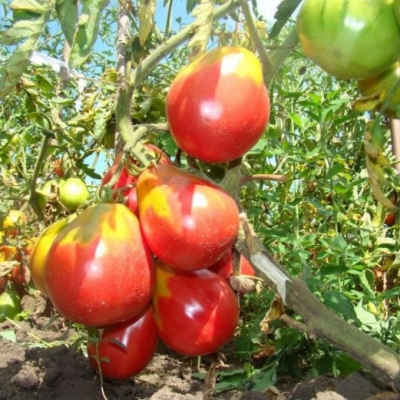
- Authors: Dederko V.N., Postnikova O.V.
- Year of approval: 2008
- Category: grade
- Growth type: indeterminate
- Appointment: fresh consumption
- Ripening period: mid-season
- Growing conditions: for open ground, for film greenhouses
- Bush height, cm: 100-160
- Leaves: large, green
- Unripe fruit color: green with a dark spot at the stalk
Due to its attractive name, the Ivan Kupala variety attracted the attention of many Russian summer residents. This crop can grow and bear fruit in any region of the country. The variety is unpretentious in care, and the fruits are distinguished by an unusual shape and refined taste.
Description of the variety
Ivan Kupala is recommended for growing in film greenhouses and in open beds. Ripe fruits are eaten fresh. The type of growth of the bush is indeterminate. Plant height varies from 100 to 160 centimeters. Shoots are covered with large bright green leaves. The leaves are elongated and have smooth edges. The foliage is strong. Up to 7 tomatoes are formed on one brush. The inflorescences are simple.
The main qualities of the fruit
Unripe green tomatoes have a dark spot around the stalk. Ripe vegetables turn raspberry. The crop has an uncharacteristic shape for tomatoes. The fruits are pear-like and are covered with ribs. In weight, they gain from 147 to 164 grams on average. The pulp is medium in density. The skin is firm, but not felt during use.
Tomatoes do not crack during transportation and storage. Keeping life up to 10 days. In addition to fresh consumption, ripe vegetables are great for harvesting for the winter or making marinades. Some housewives prefer to make juices and ketchups from them.
Note: despite the dense skin, long-term transportation of the variety is contraindicated.
Taste characteristics
The taste of the crop is excellent. Fully ripe tomatoes are sweet and juicy, without sourness.
Ripening and fruiting
By the timing of the ripening of the crop, the variety is mid-season.
Yield
The yield of the Ivan Kupala variety is quite high. About 9.5 kilograms of vegetables are obtained from a square meter of the plantation. One bush can be harvested from 2 to 3 kilograms of crops.
The timing of planting seedlings and planting in the ground
Sowing material is sown 60-65 days before the day of planting seedlings in a permanent place. With this in mind, you can calculate the exact timing of planting. Before germination, seeds must be dipped in a saline solution to test for germination. A teaspoon of salt is dissolved in a liter of water. Grains are sent to the resulting composition for 10 minutes. The floating seeds are thrown away.
After disinfection is carried out with a solution of manganese (processed for 20-30 minutes) or hydrogen peroxide (8 minutes). The inoculum is placed in cheesecloth and in solution. To obtain seedlings, the seeds are evenly placed between two sheets of gauze, moistened and transferred to a warm place (temperature from 22 to 25 degrees). The soil is irrigated regularly. With a lack of sunlight, additional lighting devices are used.
For growing seedlings, use separate containers made of plastic or peat. A wooden box is also suitable, in which the seedlings are germinated before picking. After the formation of the first sprouts, the temperature in the room should be reduced to 18 degrees Celsius.

Growing tomato seedlings is an extremely important process, because it largely depends on whether the gardener can harvest at all. All aspects must be taken into account, from seedbed preparation to planting in the ground.
Landing scheme
When making a planting, you need to leave 0.5 meters of space between the bushes and rows. No more than 4 bushes are placed on a square meter of land.

Growing and care
Once the ground has warmed up enough, it's time to transplant the finished seedlings to a new location. After transplanting, the soil must be loosened, spud and irrigated. Plants need a week to adapt to a new place. To retain moisture, the ground is covered with mulch. Dry weeds or straw will do. Organic matter not only maintains the desired level of moisture, but also nourishes the earth with useful microelements in the process of decomposition. Mulching also protects the bushes from dangerous insects.
After 7 days, they begin to irrigate the land regularly. They moisten the bushes strictly at the root so that moisture does not get on the leaves and stems. Use settled and warm water. Tomatoes are watered 2 times a week, but in hot and dry seasons, irrigation is carried out 3-4 times a week. It is important to carefully monitor the condition of the earth and prevent waterlogging of the soil. Dampness negatively affects bushes and crops. Also, stagnant water provokes the development of fungus.
Nutrients are indispensable. The first fertilizers are used 2 weeks after transplanting. They choose organic matter (chicken droppings are widespread) or mineral compositions. Before applying, organic matter must be diluted with water so as not to burn the roots. The recommended ratio is 1: 15. The second time the plants are fed when buds appear. The last dressing is applied when the crop is set.
Another important condition for growing tomatoes Ivan Kupala is regular pinching. If the lateral shoots are left, the fruits will not receive enough nutrients. Tomatoes will become smaller and lose their high gastronomic quality. Lateral processes are removed when their length reaches from 4 to 8 centimeters. This way the plant will experience minimal stress. To protect the culture from infections, it is treated with a manganese solution.
Experienced gardeners are advised to form bushes into 2 stems. This promotes maximum fruiting.




A plant needs different micronutrients at each stage of growth. All fertilizers can be divided into two groups: mineral and organic.Folk remedies are often used: iodine, yeast, bird droppings, eggshells.
It is important to observe the rate and period of feeding. This also applies to folk remedies and organic fertilizers.



























































































